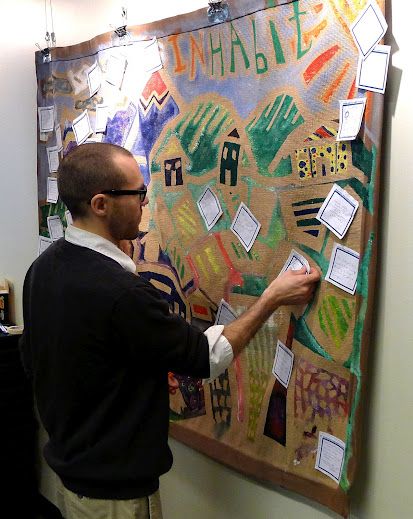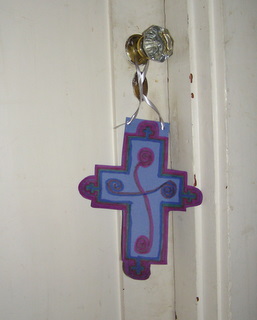
In Bread for the Journey: A Daybook of Wisdom and Faith, Henri Nouwen says:
Discipline in the spiritual life is the concentrated effort to create the space and time where God can become our master and where we can respond to God’s guidance. Thus, discipline is the creation of boundaries that keep time and space open for God – a time and place where God’s gracious presence can be acknowledged and responded to.
Discipline has almost become a dirty word in our society. Boundaries and limits make us feel as though we can’t breathe or that we have lost our freedom.
I well remember a friend of ours who spent several weeks in a monastery. He told me that before he went he thought that having to stop for prayer several times a day would be stifling. Instead he found it to be liberating. It took my focus away from work as the most important thing to God, he told me.
How often is our lack of discipline because our eyes are on something other than God?How often do we lack discipline because we want the freedom to do anything we like without being accountable to God or to anyone else around us?
Think about what Nouwen says. Rather than emphacizing the rigours of repetitive action that many of us struggle he focuses on the result – time & space for God. What spiritual disciplines have you avoided with the excuse that they are repetitive or ritualistic and yet in the process lost time and space with God? What is one discipline you could initiate that would help create necessary boundaries to protect your time with God?
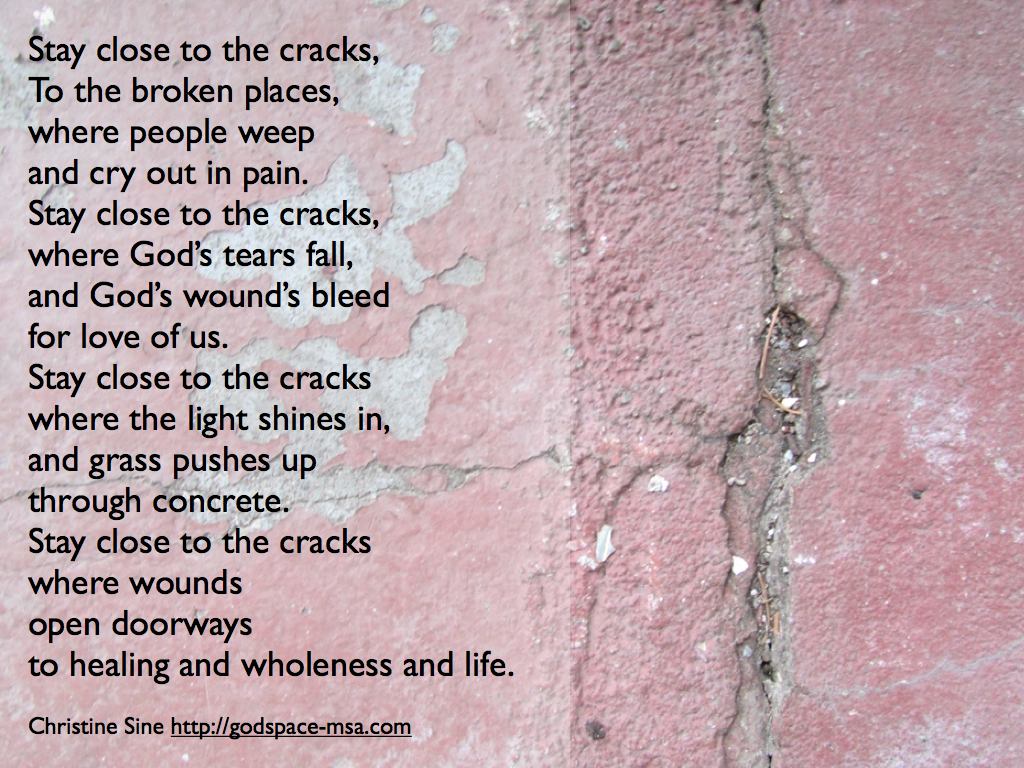
In Eager to Love, Richard Rohr comments that St Francis of Assisi asked us to stay close to the cracks in the social fabric of our world. It is a thought worth reflecting on.
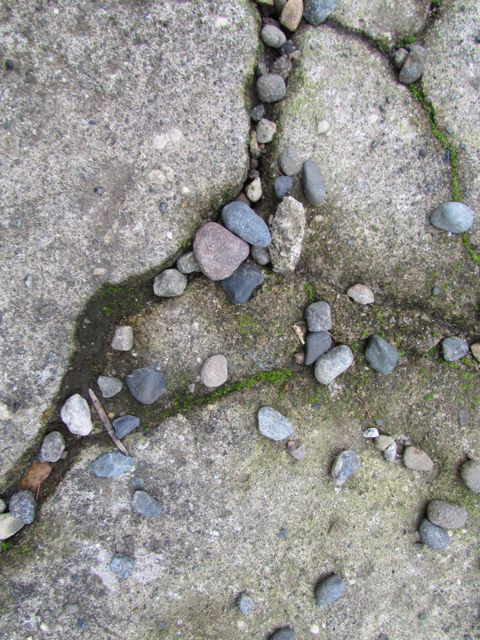
Everything in our lives and in our world has cracks, wounds and broken places that tell of pain and suffering. Sometimes we try to cover them over, attempting to seal them off from the light. But this only makes them fester and get worse.
Yet it is in the cracks, the broken places of our lives, where violence flares and pain cries out that healing happens. When we acknowledge imperfections, we take the first step towards wholeness. It is into the cracks that light can shine and water can seep. It is in the cracks in the concrete that seeds can lodge, germinate and take root. And as green shoots reach for the sky, the crack enlarges, the concrete crumbles and what was meant to live and breathe thrives once more.
What is your response?
Sit quietly in the presence of God, allowing the love of God to wash over you. Read through the prayer above several times. What cracks in your world, what places of woundedness and vulnerability that give you ongoing pain come to mind? In what ways have you tried to cover these over, perhaps with a facade of laughter or with a semblance of respectability? Are there ways you respond, perhaps with fear, or anger or intolerance that show these are festering? Perhaps there are things you need to confess or seek forgiveness for. Offer these up to God in prayer.
Now think of the light that has shone into those cracks. What has it begun to give life too? Are you aware of green shoots emerging towards the sun? How could you nurture their growth and make help them to thrive?
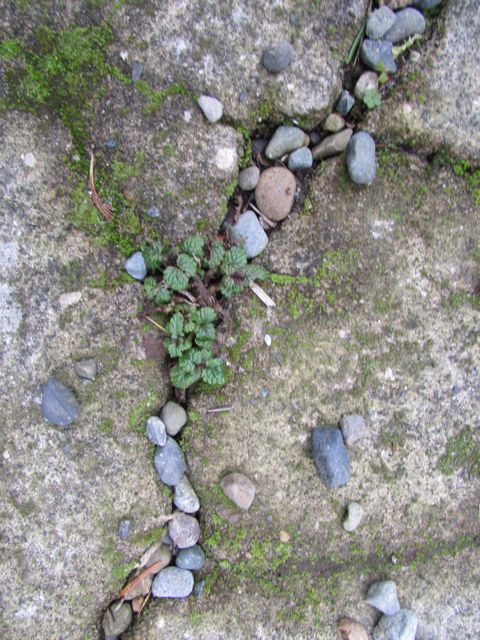
At our local mall recently I noticed that what was once a solid concrete slab of parking slots has now been transformed. Deliberate “cracks” have been added between the rows of cars – small gardens that channel the water into the topsoil and down into the water table are thriving. The rain no longer creates a flood of water that overflows the drains and clogs the waterways.
Sometimes when we stay close to the cracks we realize that they need to be nurtured and strengthened to rebuild the fabric of our lives and our society. And as we nurture these it is not only the surface life that thrives but it is the deep wellsprings of the water table that flourishes too.
What is your response?
Read through the prayer above again. What slabs of pavement are you aware of in your life and society that need to be broken up with gardens? Is there something the spirit of God is prompting you to do that could help accomplish this?
Now listen to the song below and allow the spirit of God to stir your imagination. Is there another response God is asking of you?
At Mustard Seed Associates we have many exciting resources available to celebrate the season:
“Stop Playing Games:
Return to Our Senses in Lent”
Pre-Lent Retreat
When: February 14th, 2015
Where: Union Church Kakao Cafe
415 Westlake Ave N
Seattle, WA 98109
There is still time to sign up for the retreat! Find out more HERE
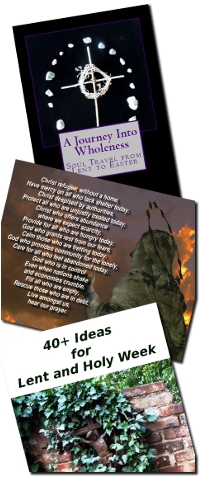 Join in God’s Reconciling Work
Join in God’s Reconciling Work
- A Journey into Wholeness: This devotional contains a rich array of reflections and activities to enable us to draw close to God and God’s purposes at this season.
- Lenten prayer cards also make a great focus for daily reflections.
- 40+ Ideas for Lent and Easter: Free Lenten activity guide
- “Stop Playing Games: Join God’s Reconciling Work For Lent“ is the featured Lenten series on the Godspace Blog.
- Updated resource lists on Godspace:
These Lenten resource lists have been shared widely, being featured amongst other rich resources by sites such as Textweek.com, Lent and Beyond, and by bloggers like Rachel Held Evans.
Stir Your Imagination for Lent
If you want to use your own creativity to imagine new possibilities for the season, check out:
- Five Ways to Foster Creativity in Kids
- Seven Tips for Creating Sacred Space in Lent
- Get Creative and Play Games for Lent
Join with us in getting ready for the Lenten season and be prepared to be drawn into God’s reconciling work!

Did we create God as an evolutionary adaptation?
In recent years scientists specializing in the mind have begun to unravel religion’s “DNA.” They have produced robust theories, backed by empirical evidence (including “imaging” studies of the brain at work), that support the conclusion that it was humans who created God, not the other way around. And the better we understand the science, the closer we can come to “no heaven … no hell … and no religion too.” Read the entire article
It is easy for people to dismiss ideas like this because we know that they are based on faulty assumptions. Its fascinating to me to see how people will do anything to rationalize away the fact that God exists. And of course they do it by starting from assumptions that are based on their belief that God does not exist. “Why do we conjure up gods the article asks?” implying that our religious beliefs are irrational thoughts that are conjured up by our imaginations. Maybe we should start from another assumption. How about we conjure up gods because God exists and there is this need deep within all of us to connect to the living God who created the universe and all that is in it. Maybe we conjure up gods because the nature of God is imprinted on our DNA… maybe it is because we are made in the image of God rather than because we have made God in our image.
On the other hand, I understand the need to do away with some of our reasons for religion. The problem is that the gods we conjure up are sometimes violent, irrational and judgmental. And we become like the gods we believe in. Part of the reason the author wants to do away with religion is because of how often it leads to violence and indifferent loveless attitudes towards others.
Before John Lennon imagined “living life in peace,” he conjured “no heaven … / no hell below us …/ and no religion too.”
No religion: What was Lennon summoning? For starters, a world without “divine” messengers, like Osama bin Laden, sparking violence. A world where mistakes, like the avoidable loss of life in Hurricane Katrina, would be rectified rather than chalked up to “God’s will.” Where politicians no longer compete to prove who believes more strongly in the irrational and untenable. Where critical thinking is an ideal. In short, a world that makes sense. Read the entire article
If this is what those who want to rationalize away God believe it is no wonder they do it.
Why I wonder do we people of faith believe in a god of love, compassion and peace when there is so much hate and violence in our world? Is it because we long for something different or is it because the intrinsic nature of humanity is the nature of God – even though we have rebelled, polluted and ignored it? Our faith should lead to greater engagement in peacemaking, a deeper passion for renewal of the earth and a longing for abundance, peace and wholeness for all. And maybe if people saw we believed in this kind of god through the way we lived and acted, they would believe in God too.
What do you think?
This is the third post on preparing for Lent and our need to stir our creativity and imagination during the season. In some ways it is ironic that our Lenten series is entitled Stop Playing Games because really what we need to do is to start playing games, stirring our imaginations through unstructured times of fun and enjoyment towards God’s work of restoration and reconciliation.
In Restoring the Wellsprings: A Lenten Retreat into Creative Practice, the authors suggest taking an “artist date” each week in Lent.
Once a week, it’s your job to take yourself out to have fun for an hour or two. Do it alone, and choose something that you might not normally allow yourself: an excursion to a gallery to look at art; a trip to a fabric store; a walk in a public garden you love, or have always wanted to visit; a ferry ride to explore the Island. This should be gratuitous and self-indulgent. In short, you are to give up self-denial for Lent.
I think this idea is spot on. The place to start if we really want to join God’s creative work of restoration is not with more disciplines or with more denial but with more time for fun and creativity.
Each moment is pregnant with new possibilities waiting to be born, alive with new beginnings, God’s secrets not yet heard, God’s dreams not yet fulfilled. These were the thoughts that lodged in my mind as I meditated on Isaiah 48:6-8 this morning. So many good Christian people I talk to are afraid that their prayer life will become stale, their spiritual disciplines empty rituals. Some make this an excuse for their lack of discipline in prayer and their lack of adherence to regular spiritual practices. Spiritual practices will become stale and meaningless if we don’t know how to stir our imaginations and awaken our creativity to new thoughts, new patterns and new possibilities.
Tools for prayer are creative opportunities not formulae for success.
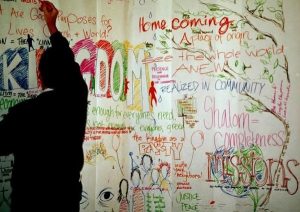 In her article 18 Things Highly Creative People Do Differently, Carolyn Gregoire shares some interesting insights on how to stir our creativity, but there are also a number of spiritual tools I have found helpful that you might like to consider as Lenten practices. Most of these tools have stimulated my own creativity in times of dry spiritual struggling. They are processes I have used to recreate my own spiritual disciplines so that I can move closer to God and the world in which I live as well as grow my understanding of who God intends me to be.
In her article 18 Things Highly Creative People Do Differently, Carolyn Gregoire shares some interesting insights on how to stir our creativity, but there are also a number of spiritual tools I have found helpful that you might like to consider as Lenten practices. Most of these tools have stimulated my own creativity in times of dry spiritual struggling. They are processes I have used to recreate my own spiritual disciplines so that I can move closer to God and the world in which I live as well as grow my understanding of who God intends me to be.
1. Lectio divina is a particularly fertile ground for imagination and creativity especially when combined with creative acts like drawing, writing and visualization.
2. Visio divina, or divine seeing, is another practice that makes a particularly good creative practice.
3. Doodling is another fun and creative tool – it may not sound very spiritual but it can be made into a powerful spiritual discipline, especially if we doodle with our non-dominant hand. I suggest that before you doodle you ask yourself a question like “how could God use me as an instrument of reconciliation during Lent?” Prayerfully close your eyes and doodle with your non-dominant hand for about 30 seconds. Open your eyes and reflect on the image. Repeat your question and ask God to speak to you. Add to the image with coloured pencils or crayons, allow God to shape it into a meaningful shape. Pause after a minute or so from colouring and ask the question again. Write down what you sense God is saying. Keep the image on your desk or in your journal and continue to add to it over the next few days or weeks.
4. Use a finger labyrinth. Again this is a great practice to do with your non-dominant hand with a very specific question to ask of God as you trace the path.
These are not the only tools that stir my imagination and awaken my creativity – walking in the garden, turning the compost, listening to music, taking photographs and even as I have shared in a previous post – meditating on rocks are all tools that can stir me to new creativity. So here are a few more suggestions.
- Be ready for change. Our lives are like drops of water in a rapidly flowing river. Everything around us is constantly changing. Yet under all of flowing water there is bedrock – the unchangeable presence of God that anchors us and keeps us secure no matter how much everything else changes.
- Live a life of curiosity. Treat everything around you as though it has a newness and a freshness to it. No matter how many times we have looked at something or someone, before we always need to be alert to the newness that Christ brings to each mundane moment and encounter.
- Always be interested in big things. Even when life seems small and restricted because of illness, disappointment or struggle, we can keep our world big by the way that we approach the situations we face. We can focus on the restrictions or we can look beyond them to the new things that God would have us discover.
- Be happy in the small thing. Our expectations are often unrealistic and can be ungodly. By focusing on our own ideas of what should happen we often put the Holy Spirit in a box that restricts what God is able to do. Our senses that make us aware of the fragrance of a rose and the sound or a waterfall are in some ways small and insignificant but it is often through them that we are made aware of the intimate presence of God. It is often our senses that make it possible for us to move beyond our disappointments and the sadness and pain of life.
And if after all of this you are still looking for resources for Lent – check out this expanded and updated list of Lenten resources.
A Series on Lent and Creativity
- Get Creative and Play Games for Lent;
- Five Ways to Foster Creativity in Kids During Lent
- Seven Tips for Creating Sacred Space For Lent
- Let’s Get Creative with Lent
- Let’s Get Creative – Doodle Your Way Through the Lenten Calendar
Godspace Resources:
- Lord Lead Us To Repentance – A Lenten meditation video produced in 2012
- Were You There When They Crucified My Lord? This meditation is designed for Good Friday and does not have music
- Is This the Fast? – A Lenten meditation produced in 2008
Yesterday, in my post on creating sacred space for Lent, I suggested that we don’t need more resources, but rather more time to sit with God and stir our imaginations and creativity so that our Lenten practices enter our hearts and souls and transforms us into the people God intends us to be. We don’t just need to have our own imaginations stirred though, we need to make sure that our children are encouraged to be imaginative and creative too.
I well remember the first Easter that Ricci Kilmer and Eliacin Rosario Cruz celebrated with us. Their four-year-old daughter, Catie, was put in charge of creativity. She had us all cut out crosses, decorate them and then hang them on the doorposts. They hung around the house for days, not just a wonderful reminder of the death and resurrection of Christ, not only of the joy of Christ’s resurrection, but also a special reminder of the wonderful gifts God gives to children and how much we need their input in our lives. For me, it was the most meaningful part of our celebrations.
When was the last time you asked your kids, grandkids or kids in your church family for creative ideas on how to celebrate Ash Wednesday, Lent or Easter? When did you last suggest they have fun planning for the season rather than planning the season for them?
Here are some suggestions on ways to stir kids imaginations so that they come up with creative and meaningful ways to celebrate the season.
1. Perhaps the best Lenten practice you could establish this year is to give kids time to be creative without interfering. Unstructured play that is child-directed rather than parent-directed is rare but it is essential if kids are to develop creative imaginations. I wonder what kids would suggest if, rather than planning an Easter egg hunt for them, we asked them to come up with a new way to celebrate Easter and made sure they had plenty of time to do that.
2. Give kids permission to fail. So much kid activity is designed for success. Failure is something we teach them consciously or unconsciously, to be afraid of. Maybe a good Lenten discipline would be to finish the day by asking your kids, “What mistakes did you make today?” Then share your own failures and laugh about them together. Have some fun.
3. Give kids freedom and space to make a mess and be willing to get messy with them. For some people I know this would be a huge sacrifice, but maybe tidiness is something you need to give up during Lent so that your kids can find the freedom of expression God desires for them during this season.
At one of our MSA retreats, Catie made us all into chocolate tasters. We were each given a small piece of chocolate to savour. We closed our eyes, and sat with the chocolate on the palm of our hand, breathing in the richness of its aroma. Then we got to taste it, noticing its texture, the way it tasted on our tongues and stirred our senses. With much laughter and hilarity, we shared our thoughts. Then we opened our eyes and with relish, licked the now molten chocolate from our fingers. We became kids together, it not only stirred Catie’s imagination and creativity but ours as well.
4. Let your kids imagine their own story. Read the story of Jesus’ time in the wilderness and let your children write or draw, whatever was interesting to them that they remembered, rather than giving them specific details from the reading what someone else found important. Over the season of Lent, go through several stories about Jesus ending during Holy week with the stories of Jesus’ walk to Jerusalem and the story of the crucifixion. Ask the kids to imagine games, and activities to go with each of the stories.
5. Create a sacred space for kids. In yesterday’s post, I talked about creating our own sacred space for Lent. The same opportunity should be given to kids. Use these suggestions to encourage kids to create their own sacred space. What music would they include, or fragrances – maybe some incense or other aromas. I think you will be amazed at the creativity that emerges.
And if you are still not sure of how to encourage creativity in your kids check out some of the ideas I listed last year in Resources for Celebrating Lent With Kids
This is part of a series on creativity and Lent.
Get Creative and Play Games in Lent
Seven Tips for Creating Sacred Space in Lent
Please check out our complete list of Godspace resources for Lent through Holy Week.
Its time to get ready for Lent and over the rest of the week, I will post links to my updated resource lists for Lent. However, I must confess that as I started to work on these I found myself struggling a little. There are so many resources available for Lent – Lenten devotional A Journey Into Wholeness, with a rich array of reflections and activities for the season, Breath prayer cards that also provide a focus on breathing (or purchase the bundle!) and free Lenten activity guide 40+ ideas for Lent and Easter and Hungering for Life. We also have Lent/Easter Prayer cards!
What we need is not more resources. We need more time to sit in the presence of God and stir our imaginations and creativity so that our Lenten practices enter our hearts and souls and transforms us into the people God intends us to be. As you know, our theme for Lent is Hungering for Life. We don’t want to tell you how to celebrate Lent, we want to invite you to stir your imagination and allow the Holy Spirit to inspire you and encourage you to take God’s reconciling work seriously during this season.
The place I suggest you start is with creating your own sacred space for Lent.
A couple of years ago, I started a practice where I burnt the crosses and palms from the previous year to make a pile of ashes that became my focus for the season. Last year, it inspired this prayer and reflection and this year I am asking God to stir my imagination in new ways in order to draw closer to God’s heart for reconciliation within myself as well as in my relationship to God, to others and to God’s creation.
So take some time to create your own sacred space for Lent. Here are some possibilities to prayerfully consider as you spend this Lenten season at home.
- Your dining room table. Eating meals is a holy time. Regardless of how busy you are in the week, make time for at least one meal to be shared with others. Believe me, you’ve got time. You’ve got to make time. And perhaps you can make this a time of reconciliation with those with whom you have been estranged.
- Something you are thinking of throwing out, like my old crosses and palms from last year. Recycled items as a focus for Lent reminds us that God is in the business of transformation and recreation.
- Clean a space for Lent. Spring cleaning was a traditional Lenten practice that symbolized the cleaning inside and out that was meant to take place during this season. What is one space you have wanted to clean up that you could recreate as a focus for Lent?
- Use colour and texture. The traditional colour for Lent is purple but that does not mean that we need to use it. Perhaps there are other colours, textures and images that speak to you about your own personal need for repentance and reconciliation. Imagine ways that you could use these to create a special place for your celebrations during this season.
- Incorporate images. I have a collection of icons, crosses and other images that I love to rearrange for different seasons on the year. Some have been given to me, others I have created, like my Celtic cross on stone from last year. I love to sit with some of these images in front me when it comes time to rearrange my sacred space and allow the spirit of God to help me choose which images are appropriate for the upcoming season. I have found this to provide a very profound experience that nurtures and instructs me throughout the season.
- Bring nature into your sacred space. By now, most of you know that I do not consider a sacred space to be complete unless it incorporates a garden, a plant or even a beautiful photo of a special landscape or flower. As one of the prime ways that God speaks to us is through the created world, I think this is important for all of us to include in our sacred spaces.
- Use your artistic gifts to create something new. All of us have been gifted with creativity and imagination, yet we rarely use it in our spiritual observances. Some of us are unaware of our creativity. Others are unsure how to create with the purposes of God in mind. Prayerfully ask God to stir your imagination to create something that flows out of the unique creativity with which God has gifted you. It could be a poem, a piece of art, a photo, a collage, something you knit, carve or sculpt. Or it could be an entirely new art form that is uniquely you.
I hope you will take time to create your own sacred space this Lent. If you do, I would love to hear about it. Leave a comment below or email me with your ideas and images.
Please check out our complete list of Godspace resources for Lent through Holy Week
As an Amazon Associate, I receive a small amount for purchases made through appropriate links.
Thank you for supporting Godspace in this way.
When referencing or quoting Godspace Light, please be sure to include the Author (Christine Sine unless otherwise noted), the Title of the article or resource, the Source link where appropriate, and ©Godspacelight.com. Thank you!

